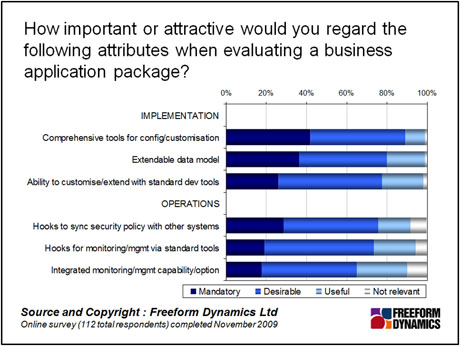While software sales and marketing people often try to convince business people that the technical stuff doesn’t matter that much when selecting an application package, respondents beg to differ.
Indeed, over a hundred of you participating in our recent mini-poll were clear in what matters from an IT perspective to ensure project success and the ongoing management of cost, risk and service levels.
It would appear that from an architectural perspective, ‘proprietary’ has become something of a dirty word. IT professionals clearly favour packages based on mainstream database and application server options, with support for open integration standards (Figure 1).

Figure 1
There is clearly a lock-in avoidance angle to this, but the question of familiarity, skills and experience is also obviously a big driver towards standard/mainstream technology, and from a business perspective, this translates to cost and risk minimisation.
The position of Service Oriented Architecture (SOA) at the bottom of the list is quite telling. It’s not that there is no interest, as low in the pecking order though it might be, more than three quarters acknowledge its usefulness, with two out of five regarding it as desirable. However, the things that SOA enables, or at least makes easier, are a lot more prominent – namely componentisation and a more standard message based approach to integration – the latter being most often implemented via Web services nowadays. There is perhaps a lesson here for any purists reading this, in that SOA is a means to an end, and provided that end is achieved, how you get there is secondary.
The other important factor worth highlighting is support for virtualisation. There is a technical dimension to this in that software packages will ideally be able to run in a virtualised environment without hitting provisioning, performance, stability or practical issues. There is also a commercial dimension requiring virtualisation friendly licensing and an acknowledgement by the supplier of the legitimacy of operating in a virtualised environment from a support and maintenance perspective.
Turning to the application deployment lifecycle, a number of things matter. While tools to enable efficient configuration and customisation during implementation are top of the list, an extendable data model and ability to use standard tools are also considered to be important for dealing with further customisation and extension requirements (Figure 2).

Figure 2
What’s also evident from this chart is the importance of being able to manage security without reinventing the wheel, i.e. where a policy management framework is already in place, the package should be able to sync or otherwise work in harmony with it.
By the same token, while it is appreciated that some aspects of monitoring and management will be specific to the application and may therefore need special integrated capability, no application should be an island from an operational point of view. The desirability of hooks to surface configuration, performance and diagnostic information to standard management tools are therefore not surprisingly highlighted by three quarters of respondents.
Beyond what’s shown in the above charts, around 40% regard integrated business intelligence and analytics as desirable, with the same number acknowledging its usefulness, and a similar picture was observed for integrated collaboration and mobile access support.
Of course beyond the software itself, there is also quite a bit to consider in terms of how well it is delivered and supported in general by the supplier. Top of the list here, according to readers, is good technical documentation, an integration friendly support model that is not based on finger pointing when troubleshooting across dependencies, and an open culture and philosophy with regard to bugs, fixes and so on (Figure 3).

Figure 3
The message here is that IT professionals like to work with suppliers that trust them with information and respect their need for openness and self sufficiency, but are there to provide support in the right spirit when it is needed. Maybe this is a bit like asking for the perfect husband or wife, but there’s nothing wrong with having aspirations.
What all of the above confirms is that there really is a lot to consider from a technology perspective when selecting packaged applications. The chances are that you probably knew this already, but it can nevertheless be useful to see where everyone else is putting the emphasis on specific points.
That’s assuming, of course, that someone has the courtesy and sense to ask you (Figure 4).

Figure 4
To be fair, this picture isn’t too bad, but if you are one of those left out in the cold during the decision making cycle, perhaps highlighting what other organisations take seriously will help to make the case for more IT involvement in the future.
Through our research and insights, we help bridge the gap between technology buyers and sellers.





Have You Read This?
From Barcode Scanning to Smart Data Capture
Beyond the Barcode: Smart Data Capture
The Evolving Role of Converged Infrastructure in Modern IT
Evaluating the Potential of Hyper-Converged Storage
Kubernetes as an enterprise multi-cloud enabler
A CX perspective on the Contact Centre
Automation of SAP Master Data Management
Tackling the software skills crunch